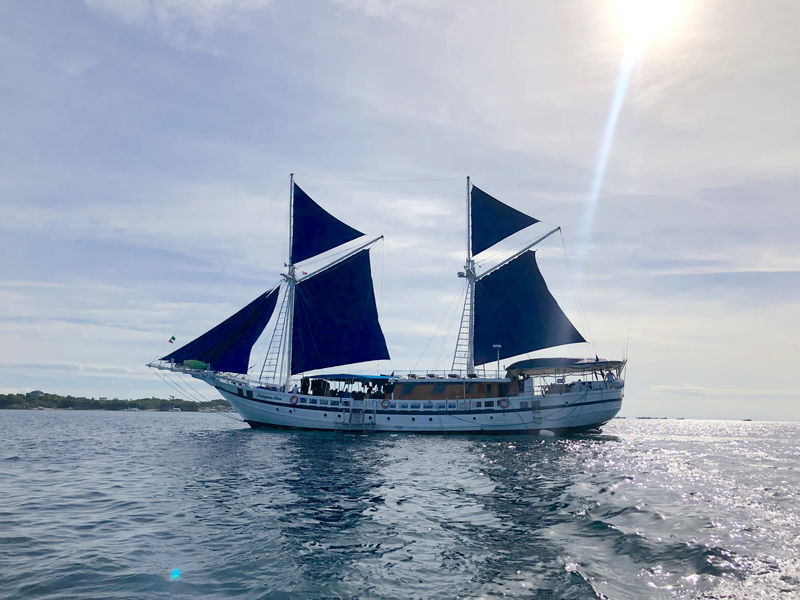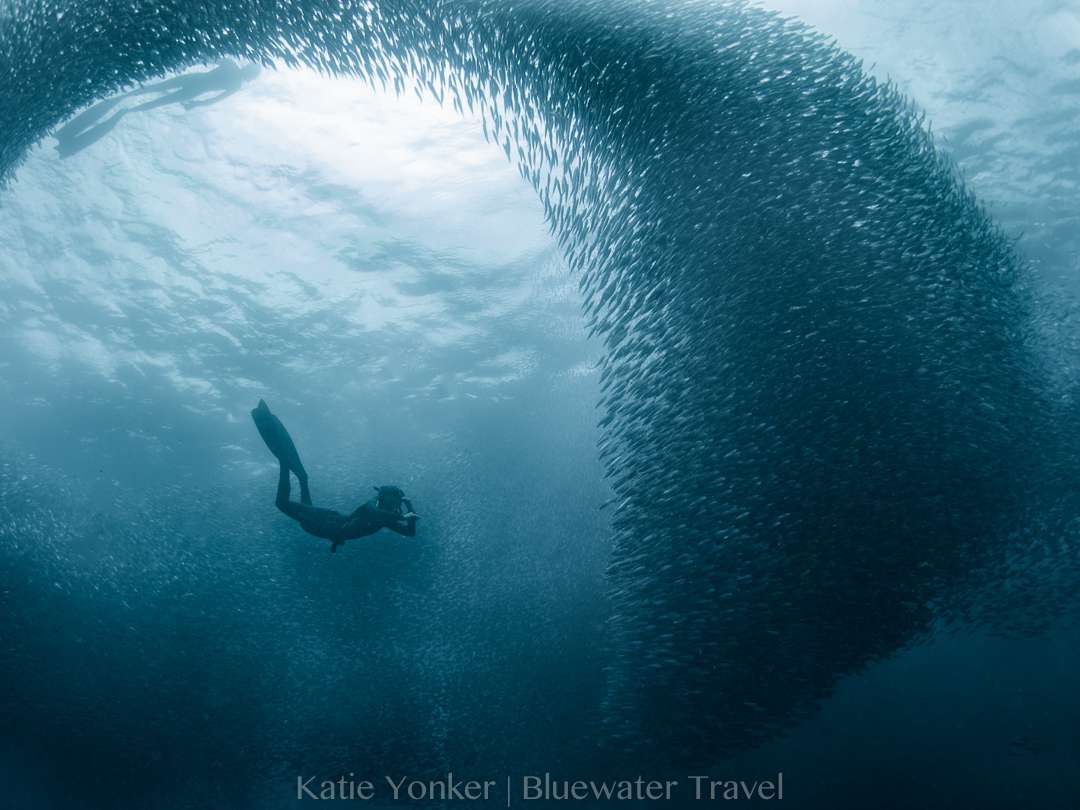Malapascua & The Visayas Trip Report - February 2019
Bluewater Travel February 2019 Trip Report - By Katie Yonker
Situated on the northern border of the Coral Triangle, the Philippines comprises over 7,500 islands spread out over 300,000 square kilometers and offers enough diversity to satisfy any diver’s interest. Some 574 species of reef-building coral create a home for nearly 1,400 species of reef fish. Dauin and Anilao dazzle with rare critters and are home to some of the world’s best macro photography subjects. Those in search of pelagic life will delight in the thresher sharks of Malapascua, whale sharks in Oslob, and can get lost in millions of schooling sardines in Moalboal. For wreck enthusiasts, Coron Bay offers some of the best Second World War wreck diving on the planet, festooned with life.
This February I had the opportunity to bring a group on the Philippine Siren to explore Malapascua and the Visayas. The Philippine Siren is a beautiful, 40-meter Phinisi dive liveaboard accommodating up to 16 guests. Upon embarkation, we were offered an ice-cold drink accompanied by a warm crew welcome, then shown to our spacious and modern cabins equipped with ensuite bathrooms, TVs, and ample storage space. There is also plenty of space on the main deck as well, including three camera tables, two dedicated storage drawers per person, and plenty of plugs to charge camera batteries. Outside on the dive deck, each guest has their own dive station including another dedicated drawer to store personal items. After our dive and safety briefings, we enjoyed our first of many exceptional meals prepared by the kitchen staff before retiring to bed, excited for the days to come.

Diving in cabilao
On the west side of Bohol lies the island of Cabilao where you’ll find several interesting wall and coral garden dive sites. Sites like Gorgonian Wall, Lighthouse, and Talisay Tree feature walls covered in huge sponges and gorgonian fans which are home to many critters such as the Santa Claus pigmy seahorse, hairy squat lobster, and orangutan crabs. Chromodoris were abundant, and we spotted a giant frogfish who posed for photos while everyone took their turn.
whale shark diving at Oslob
The following day started with a very early morning dive at Oslob, home to one of the most reliable places to see whale sharks. The whale sharks of Oslob are domesticated creatures that return every morning, every day of the year, to feed on krill that is fed to them by local fisherman. This practice started years ago when fisherman would set out in their small outrigger canoes to fish for shrimp using fine mesh nets. The whale sharks would then show up to feed on the same shrimp the fisherman were after, occasionally destroying nets in the process. The story goes that the fisherman discovered if they fed the whale sharks some of their catch they could lead the sharks away from boats actively fishing. Today, proponents claim that turning this site into a tourist activity with heavy oversight has prevented these animals from being poached. Critics argue that feeding wildlife is not sustainable and this practice can lead to behavioral changes that result in long-term negative impact. Though we don’t fully know what effects whale shark tourism may bring in the future, there’s no sign of a slow down at Oslob.
diving in dauin
Arguably some of the best macro diving in the Philippines, the dive sites at Dauin offer muck diving that rivals that in North Sulawesi. The aptly-named Cars dive sites features two Volkswagens that were sunk to create artificial reefs which attract schools of lionfish, nudibranchs, porcelain crabs, frogfish, seahorses, and many species of ghost pipefish. Our night dive at Orica Pier treated us to several different types of frogfish (freckled, warty, and painted), flamboyant cuttlefish, bobtail squid, and several species of crabs and nudibranchs. By the time we finished diving Coconut Point, Thalatta, and San Miguel, we were completely spoiled by more frogfish, nudibranchs, pipefish, and crustaceans encounters than we could count. For wide angle enthusiasts, there’s also a good amount of colorful soft coral along the Dauin Coast.
DIVING IN apo island
Apo Island Marine Reserve is one of most successful marine sanctuaries established in the Philippines. Not to be confused with Apo Reef, Apo Island is located 30 km south of Dumaguete City and is heavily regulated to ensure that regular visits by divers and snorkelers do not diminish the quality of the thriving reef. Coconut Point is often a strong current drift over a sloping coral reef wall where giant trevally, humphead parrotfish, and marbled groupers can be seen while green sea turtles cruise effortlessly in the currents. Just beyond the chapel opposite the marine park warden’s office, Rocky Point offers some of the most stunning hard corals to be found in the region. The steep reef walls support numerous colorful reef species – butterflyfish and red-toothed trigger fish are here in the hundreds, and frogfish, cuttlefish, banded sea snakes, and hawksbill turtles are amongst the common sightings.
diving in moalboal
We did two dives in Moalboal, both of which should be at the top of any diver’s list if they’re visiting this area. Pescador Island features a dramatic wall covered in different colors of soft corals teeming with anthias. On the west side of the island there’s a large cathedral which makes for some dramatic shots when the lighting is right. The other site, Panagsama Beach, has something no other site does – massive schools of vertigo-inducing sardines, recently estimated at 7 million, swirling in mesmerizing patterns as snorkelers on the surface dive down to swim through them. While the photography opportunities here are incredible, it’s worth putting your camera down for at least a few minutes to take in the incredible symphony of movement.
diving in Malapascua
Though Malapascua did offer some of the best critter diving on the trip, the biggest draw here is the opportunity to see the beautiful thresher sharks of Monad Shoal which are generally here on a daily basis. Divers rest at approximately 25m (90ft) on the sandy bottom to watch the sharks approach and be cleaned. Due to the skittish nature of these sharks, strobes are not allowed, and nitrox is highly encouraged to enjoy extended bottom time. The threshers are most commonly sighted first thing in the morning when the sun rises, which makes for a very early morning dive. There are also numerous shallow reef sites dotted around Malapascua that offered excellent macro photography opportunities. Commonly sighted are a variety of anemone fish, flamboyant cuttlefish, seahorses, frogfish, ghost pipefish, cowries, porcelain crabs, and occasional schools of batfish.
The Malapascua and Visayas itinerary offers divers a wide diversity of marine life from the tiniest of critters to massive whale sharks, and everything in-between. Photographers and non-photographers alike will be delighted with the exceptionally healthy reefs, beautiful topside scenery, and friendly Filipino hospitality. As the oft-repeated tag phrase on the Philippine Siren goes, “what are you waiting for?!”
Let Bluewater Travel help you plan and book your own trip to the Philippines by sending us an email.
About the Author
Katie Yonker is the Director of Operations and a Travel Advisor for Bluewater Travel. An avid diver and travel planner, Katie’s adventures have taken her to the far reaches of the globe to destinations such as Micronesia, Indonesia, the Philippines, French Polynesia, Palau, Australia, Papua New Guinea, Fiji, Red Sea, South Africa, Maldives, Hawaii, Galapagos, Cocos, Socorro, Central America, the Caribbean, and many non-dive locations.




























